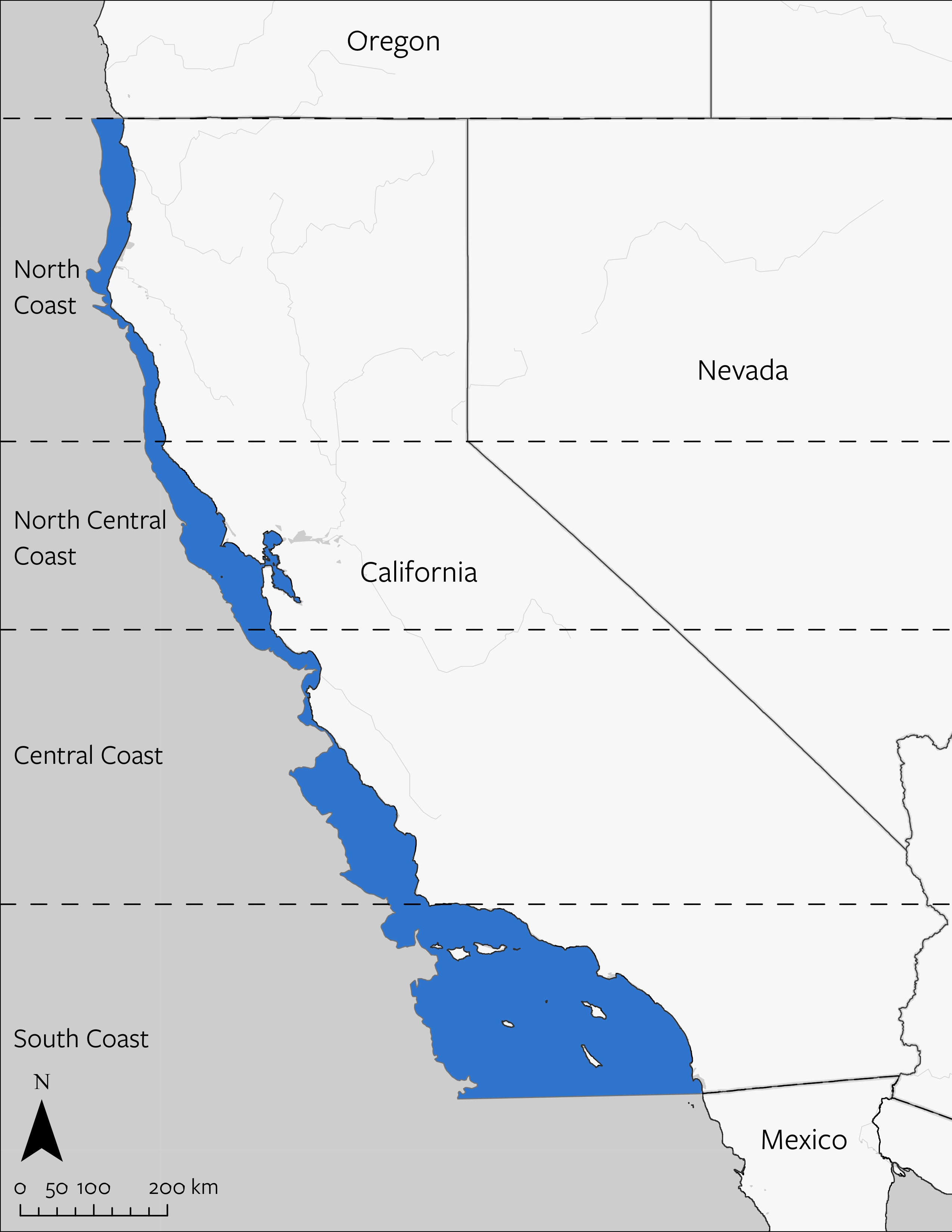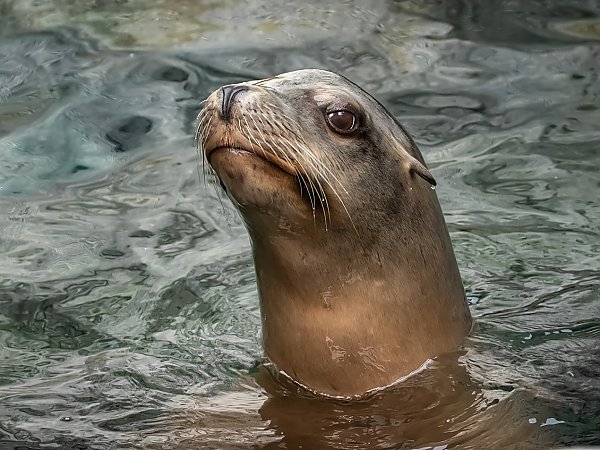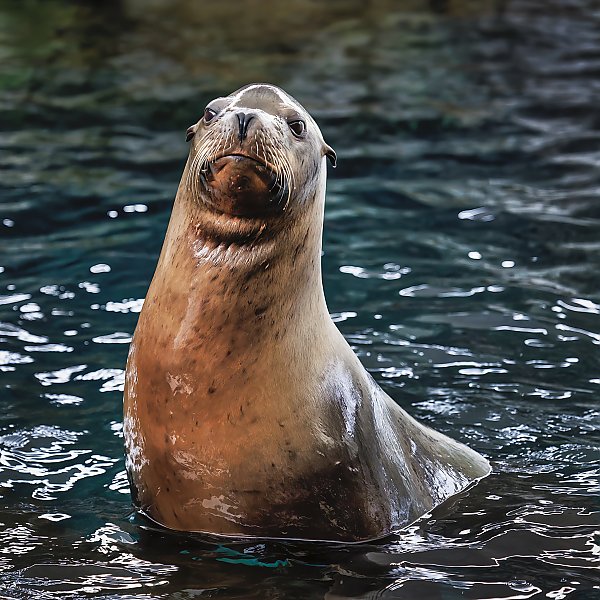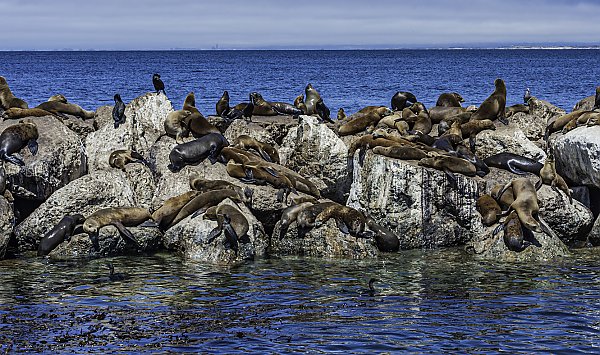California Sea Lion
Zalophus californianus
California Sea Lion
Zalophus californianus
California sea lions are thought to be at their carrying capacity – meaning that any additional increases in number are limited by food availability.
Morphology
California sea lions are members of the “eared seal” family, so-called because of their external ear flaps which help amplify and identify the location of sounds. Sea lions are sexually dimorphic with adult males distinguished by a sagittal crest on their forehead. If you have ever visited a pier off the coast of California and heard a group of animals barking loudly, those were probably male sea lions! Sea lions are very vocal and use these barks to communicate with each other. Males are larger than females – growing to weights of up to 390 kilograms compared to females, which can grow to weigh as much as 110 kilograms. Sea lion hind flippers are used for steering when underwater, but on land can be flipped under them as they “walk” on all fours.
Habitat and Range
California sea lions are found along the eastern North Pacific Ocean, ranging from Southeast Alaska to Central Mexico, including the Gulf of California. Their primary breeding range extends from the Channel Islands in Southern California to Central Mexico. California sea lions prefer sandy beaches or rocky coves for breeding and resting sites.
Range Map

Reproductive Biology and Life History
Sea lions reach sexual maturity at 4 to 5 years old, but males do not become socially mature until they are around 9 to 12 years old. In the wild, males can live up to 19 years, while females tend to live longer, around 25 years. Males are polygynous, establishing territories that can include up to 14 females. They defend these territories through aggressive physical displays and vocalizations. Females have a gestation period of about 11 months, including a delayed implantation phase where the fertilized egg remains dormant for several months before attaching to the uterine wall. Pups are nursed for nearly a year, with mothers alternating between nursing on shore and feeding at sea. During the mother’s absence, the pup remains on shore.
Ecology
Like many marine mammals, sea lions feed on a variety of fish and invertebrate species such as anchovies, rockfish and squid. In seeking prey, these sea lions are capable of diving to depths of up to 400 meters, but typically forage in shallower waters. Although most of their dives last for 3 to 5 minutes, they can stay underwater for more than 10 minutes thanks to a slowed heart rate when diving and increased blood volume to hold on to oxygen. They have excellent underwater vision which, combined with their ability to swim at speeds of 40 kilometers per hour and an ability to change directions rapidly, makes them superb hunters of fish.
Cultural Significance and Historical Context
Human exploitation of California sea lions has a long history beginning with the Tongva, who sustainably harvested sea lions on Catalina Island for centuries by targeting primarily subadult sea lions. Spanish hunters began using sea lion blubber for oil in the early 19th century, and exploitation for blubber oil increased dramatically from the 1810s to the early 20th century. Eventually, spurred by severe declines in sea lion abundance, California extended protection to sea lions from commercial harvest in 1909, and commercial exploitation outside California largely ceased by the 1930s. The population had plummeted to as few as 10,000. Thanks to California’s protection and later the Marine Mammal Protection Act of 1972, the sea lion population has increased tenfold and is now well over 100,000.
Date modified: January 2025
This animal can be found at the Aquarium of the Pacific
Primary ThreatsPrimary Threats Conditions
Threats and Conservation Status
California sea lions have been monitored for decades at sites throughout California. Depending on the monitoring program, counts may be made of pups or adults. For most Channel Islands, data are available only up until 2014. One exception is San Miguel Island, where a complete data set is available through 2023, with only one missing year. Below we show the data for San Miguel Island which is thought to be a good indicator since that island accounts for as much as 40% of the annual pup production.
The trend is one of a weak increase in pup productivity over the twenty-five year span, with considerable fluctuation from year to year in pup counts. Some wildlife biologists believe California sea lions have reached their carrying capacity – although that capacity fluctuates with ocean conditions and food availability, which explains the fluctuating numbers from year to year.
When populations of an apex predator like sea lions rebound, the management challenge switches from conservation to learning to live with these predators. Sea lions may compete with commercial and recreational fisheries for the same fish stocks, such as anchovies, sardines, and squid. This competition may result in economic losses for fishermen. In response, fishermen have used non-lethal deterrents to try to keep sea lions away from their nets, but these methods are often ineffective.
Frustration with sea lions competing for desirable fish stocks has occasionally led to illegal actions, including shooting sea lions. In addition to illegal killing by fishermen, sea lions can become tangled in fishing gear, ingest plastics, or suffer from domoic acid poisoning that arises from toxic algal blooms. While each of these sources of mortality are of some concern, the population of sea lions as a whole appear to be thriving. Sea lions may face threats in the future from lack of food availability as fish stocks decline or become threatened.
Population Plots


Data Source: Data were obtained from NOAA’s integrated assessment of California current indicators (see https://www.integratedecosystemassessment.noaa.gov/regions/california-current/california-current-iea-indicators) and NOAA’s assessment of California Sea Lion breeding season distribution and population growth in the United States from 1964-2014 (see https://repository.library.noaa.gov/view/noaa/14198).



